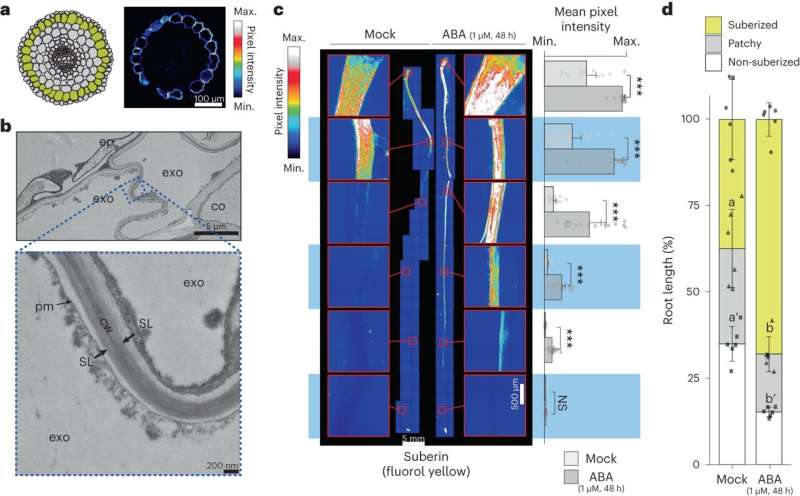
Suberin is deposited in the tomato exodermis and is regulated by ABA. Credit: Nature Plants (2024). DOI: 10.1038/s41477-023-01567-x
Plants have to be flexible to survive environmental changes, and the adaptive methods they deploy must often be as changeable as the shifts in climate and condition to which they adapt. To cope with drought, plant roots produce a water-repellent polymer called suberin that blocks water from flowing up towards the leaves, where it would quickly evaporate. Without suberin, the resulting water loss would be like leaving the tap running.
In some plants, suberin is produced by endodermal cells that line the vessels inside the roots. But in others, like tomatoes, suberin is produced in exodermal cells that sit just below the skin of the root.
The role of exodermal suberin has long been unknown, but a new study by researchers at the University of California, Davis, published Jan. 2 in Nature Plants shows that it serves the same function as endodermal suberin, and that without it, tomato plants are less able to cope with water stress. This information could help scientists design drought-resistant crops.
“This adds exodermal suberin to our toolbox of ways to help plants survive for longer and cope with drought,” said Siobhan Brady, professor in the UC Davis Department of Plant Biology and Genome Center, and senior author on the paper. “It’s almost like a jigsaw puzzle—if you can figure out which cells have modifications that protect the plant during difficult environmental conditions, you can start to ask questions like, if you build those defenses up one upon the other, does it make the plant stronger?”
In the new study, postdoctoral scholar Alex Cantó-Pastor worked with Brady and an international team of collaborators to uncover the role of exodermal suberin and map the genetic pathways that regulate its production.
Combining new and classical methods
“It’s really the merging of classical and cutting-edge methodology that lets us look at both the process that’s happening in an individual cell and what you see in the whole plant,” said Brady. “So going from super small to really, really big.”
New work by Prof. Siobhan Brady and Alex Cantó-Pastor at the UC Davis College of Biological Sciences shows how tomato plants can make themselves more drought-tolerant by producing a waxy substance, suberin, in their roots. Credit: TJ Ushing/UC Davis College of Biological Sciences
Brady, Cantó-Pastor and colleagues started by identifying all of the genes that are actively used by root exodermal cells. Then they performed gene editing to create mutant strains of tomato plant that lacked functional versions of several genes they suspected might be involved in suberin production. They discovered seven genes that were necessary for suberin deposition.
Next, the researchers tested exodermal suberin’s role in drought tolerance by exposing some of the mutant tomato plants to a ten-day drought. For these experiments, the researchers focused on two genes: SIASFT, an enzyme involved in suberin production and SlMYB92, a transcription factor that controls the expression of other genes involved in suberin production.
The experiments confirmed that both genes are necessary for suberin production and that without them, tomato plants are less able to cope with water stress. The mutant plants grew as well as normal plants when they were well-watered but became significantly more wilted after ten days with no water.
“In both of those cases where you have mutations in those genes, the plants are more stressed and they’re not able to respond to drought conditions,” Brady said.
Having shown suberin’s worth in a greenhouse setting, the researchers now plan to test suberin’s drought-proofing potential in the field.
“We’ve been working on taking this finding and putting it into the field to try and make tomatoes more drought tolerant,” Brady said.
More information:
Alex Cantó-Pastor et al, A suberized exodermis is required for tomato drought tolerance, Nature Plants (2024). DOI: 10.1038/s41477-023-01567-x
Citation:
How tomato plants use their roots to ration water during drought (2024, January 2)
retrieved 3 January 2024
from https://phys.org/news/2024-01-tomato-roots-ration-drought.html
This document is subject to copyright. Apart from any fair dealing for the purpose of private study or research, no
part may be reproduced without the written permission. The content is provided for information purposes only.
>>> Read full article>>>
Copyright for syndicated content belongs to the linked Source : Phys.org – https://phys.org/news/2024-01-tomato-roots-ration-drought.html
